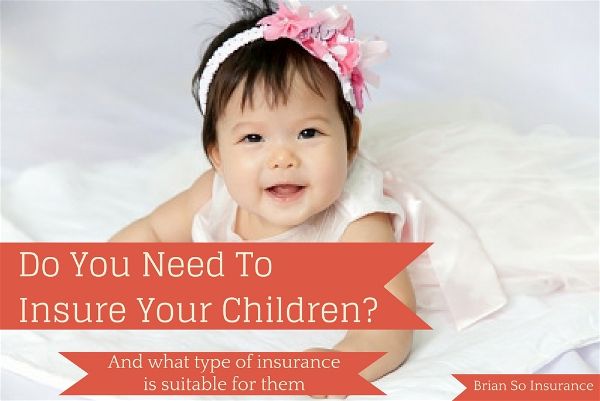
Last week we looked at if insurance was necessary for the elderly, so we’ll follow it up this week with the same question applied to children. Children are the pride of our lives. They bring joy and smiles to their parents’ faces. But they’re obviously not the breadwinner of the family – that role belongs to the parents. Still, as we explained last week, that is not the only qualifier for whether or not to have insurance placed on a family member. Are there other reasons for you to insure your children?
Do you need to insure your children?
Imagine if your child passed away or suffered a critical illness. Even though they are not earning an income, your family’s finance will be dramatically affected. You and your spouse may need to take a leave of absence from work to take care of your child, putting a stop to your income. In BC, an employee is entitled to only 3 days of unpaid leave following the passing of an immediate family member. There is no parent in the world that only requires 3 days to return to work following their child’s passing. Typically, a grieving period of a few months to over a year may be needed. Child life insurance can cover the cost of ongoing bills while the income has temporarily stopped.
Many term and permanent policies on parents allow you to add a child life insurance rider that provides a small amount – usually $5,000-$25,000 – of life insurance on each child. The rider is relatively inexpensive and typically will allow you to add new members to the family at no cost.
The other purpose of having life insurance on a child is as part of a savings plan. Most permanent life insurance policies allow for tax-sheltered growth of investments. Since young children won’t have an income to generate RRSP contribution room and are not eligible for the TFSA until age 18, a permanent life insurance policy can be used instead for the long-term growth of investments for the child.
Critical illness insurance has priority
Although life insurance is the first type of insurance that comes to mind, child mortality rates are quite low. Instead, children are vulnerable to many of the diseases that are traditionally thought to affect adults more frequently, such as cancer, heart disease, and organ failure. Critical illness insurance pays out a lump sum amount if your child suffers one of the 29 or 30 covered illnesses and survives for 30 days. Covered illnesses include life-threatening cancer, heart attack, bacterial meningitis, loss of limbs as well as 5 childhood conditions: cerebral palsy, congenital heart disease, cystic fibrosis, muscular dystrophy, and type 1 diabetes mellitus. Covered illnesses vary slightly by insurance company. For a full list, refer to the critical illness page.
If you feel life insurance is also important for your children to lock in their insurability while they are young and healthy, you can look at a combination product such as Industrial Alliance’s Child Life and Health Duo, which provides permanent life insurance combined with critical illness insurance until they reach adulthood.
For any of the covered critical illnesses, there may be specialized treatments not subsidized by MSP or your group plan. Or you may want to give the best treatment for your child at the Mayo Clinic. You may even have to modify your home or vehicle to improve accessibility. You can use the lump sum benefit to reduce the financial impact while you’re away from work to focus on your child’s recovery. As you can see, there are many ways to use the lump sum benefit from a critical illness insurance policy.
Child critical illness insurance is also convertible to an adult policy at a certain age, usually 25. The convertibility option is guaranteed, and there are no underwriting requirements. This is an important provision to have in case your child has developed any medical issues that would make it difficult for him/her to acquire a new policy as an adult.
The two main types of insurance for children: life and critical illness, can give you peace of mind that your financial goals remain intact during difficult times. While critical illnesses are unexpected and take a toll on you and your family emotionally, don’t let it ruin your family’s finances at the same time.
Image courtesy of Jomphong / FreeDigitalPhotos.net

